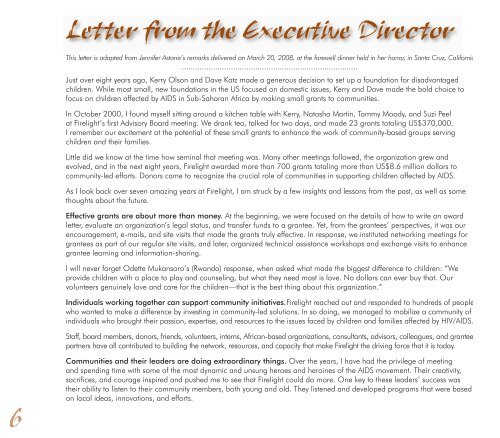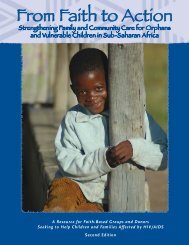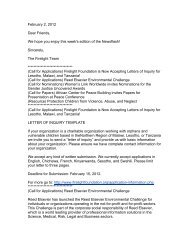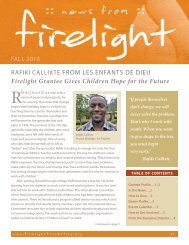FIRELIGHT FOUND ATION
FIRELIGHT FOUND ATION
FIRELIGHT FOUND ATION
Create successful ePaper yourself
Turn your PDF publications into a flip-book with our unique Google optimized e-Paper software.
This letter is adapted from Jennifer Astone’s remarks delivered on March 20, 2008, at the farewell dinner held in her honor, in Santa Cruz, California.<br />
...............................................................................<br />
Just over eight years ago, Kerry Olson and Dave Katz made a generous decision to set up a foundation for disadvantaged<br />
children. While most small, new foundations in the US focused on domestic issues, Kerry and Dave made the bold choice to<br />
focus on children affected by AIDS in Sub-Saharan Africa by making small grants to communities.<br />
In October 2000, I found myself sitting around a kitchen table with Kerry, Natasha Martin, Tammy Moody, and Suzi Peel<br />
at Firelight’s first Advisory Board meeting. We drank tea, talked for two days, and made 23 grants totaling US$370,000.<br />
I remember our excitement at the potential of these small grants to enhance the work of community-based groups serving<br />
children and their families.<br />
Little did we know at the time how seminal that meeting was. Many other meetings followed, the organization grew and<br />
evolved, and in the next eight years, Firelight awarded more than 700 grants totaling more than US$8.6 million dollars to<br />
community-led efforts. Donors came to recognize the crucial role of communities in supporting children affected by AIDS.<br />
As I look back over seven amazing years at Firelight, I am struck by a few insights and lessons from the past, as well as some<br />
thoughts about the future.<br />
Effective grants are about more than money. At the beginning, we were focused on the details of how to write an award<br />
letter, evaluate an organization’s legal status, and transfer funds to a grantee. Yet, from the grantees’ perspectives, it was our<br />
encouragement, e-mails, and site visits that made the grants truly effective. In response, we instituted networking meetings for<br />
grantees as part of our regular site visits, and later, organized technical assistance workshops and exchange visits to enhance<br />
grantee learning and information-sharing.<br />
I will never forget Odette Mukansoro’s (Rwanda) response, when asked what made the biggest difference to children: “We<br />
provide children with a place to play and counseling, but what they need most is love. No dollars can ever buy that. Our<br />
volunteers genuinely love and care for the children—that is the best thing about this organization.”<br />
Individuals working together can support community initiatives.Firelight reached out and responded to hundreds of people<br />
who wanted to make a difference by investing in community-led solutions. In so doing, we managed to mobilize a community of<br />
individuals who brought their passion, expertise, and resources to the issues faced by children and families affected by HIV/AIDS.<br />
Staff, board members, donors, friends, volunteers, interns, African-based organizations, consultants, advisors, colleagues, and granteepartners<br />
have all contributed to building the network, resources, and capacity that make Firelight the driving force that it is today.<br />
Communities and their leaders are doing extraordinary things. Over the years, I have had the privilege of meeting<br />
and spending time with some of the most dynamic and unsung heroes and heroines of the AIDS movement. Their creativity,<br />
sacrifices, and courage inspired and pushed me to see that Firelight could do more. One key to these leaders’ success was<br />
their ability to listen to their community members, both young and old. They listened and developed programs that were based<br />
on local ideas, innovations, and efforts.








